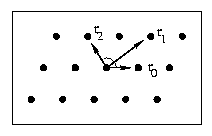
![[MAP Logo]](../../maplogo1.gif)
| Language: | C and FORTRAN |
| Product form: | Source code and compiled LINUX executable. |
This is a self-contained program.
The program needs inputs from the user :-
1) The possible precipitates has to be selected in the data file 'ppt.dat'. The program is written for the crystal structures 'CUBIC, FCC, HEXAGONAL, ORTHORHOMBIC and TETRAGONAL' only. The format of 'ppt.dat' file is;
TYPE
CODE a
b c
PRECIPITATE POSSIBLE_OR_NOT
HEXAGONAL 3
2.888 0
4.559 (Cr,Mo)_2(C,N)
0
HEXAGONAL 3
2.79
0 4.46
Cr_2C
0
FCC
2 10.6454
0 0
Cr_21.34Fe_1.66C_6 0
CUBIC
1
8.9
0 0
Cr_12Fe_36Mo_10 0
TETRAGONAL 5
9.17
0 4.741
CrFeMn-Sigma
0
TETRAGONAL 5
3.037
0 7.391
CrNbN
1
The crystal structure data present in 'ppt.dat' was collected
from 'Selected Powder Diffraction Data for Metals and Alloys,
JCPDS International Center for Diffraction Data, Pennsylvania, USA, 1978'.
The user can add or modify the data according to the format.
2) The camera constant may be known. In the present program a typical camera constant is given as an example.
3) The program needs input of length of r from a pair of reciprocal lattice vectors and the angle between the two vectors concerned. The angle between pair of vectors should be given with respect to vector r0 , as shown in the following figure.

During calculations crystallographically equivalent solutions can be avoided, but this may increase the computing time required.
INPUT FILE name of PRECIPITATES DATA : ppt.dat
Camera Length (mm) : 1370
*********************************************
FOR JEOL 200 at 200 kV on 2-6-2000
Camera Length[cm] Camera Constant
82
0.02439
137
0.02452
205
0.02527
*********************************************
Camera Constant (A) : 0.02452
Do you wish to avoid crystallographically
equivalent solutions (0 = No, 1 = Yes) : 1
Specify maximum range of Miller Index
Typical value = 3 (avoid values > 4)
Larger values lead to longer run times : 4
Accuracy of measurement ? (Typical value 0.03) :
0.03
No. of Planes to Index: 3
R0 (mm): 12.4
R1 (mm): 16
Angle between R0 and
R1 : 45
R2 (mm): 21
Angle between R0 and
R2 : 130
Top | Next | Prev
Precipitates data file : ppt.dat
Camera length : 1370.000 mm
Camera Constant : 0.024520 A
Maximum range of Miller Index: 4
Accuracy : 0.030
R[0] = 15.00000 d[0] = 2.28333
R[1] = 16.25000 d[1] = 2.10769 Angle = 24.000
[R0 - R1]
R[2] = 6.60000 d[2] = 5.18939 Angle = 90.000
[R0 - R2]
*********** SELECTED PRECIPITATES **************
TYPE CODE a b c PRECIPITATE
ORTHORHOMBIC 4
4.525 5.087
6.743
Fe_3C
CUBIC
1 10.591
0
0
Fe_23(C,B)_6
***********************************************************
**
**
Lattice
Parameters "a", "b", "c" ?
ORTHORHOMBIC
SYSTEM 4.5250 5.0870
6.7430 ANGSTROMS
D1= 2.28333306
D2= 2.107692
Angle between 2.28333306 and 2.107692 =
24.
------------------------------------------------------------------------------
Vector 1
Vector 2
Zone Axis
(h k l) d (h k l) d [U V W] Angle
0. -1. -3. 2.0559 0. 0. -3. 2.2477 1.0000 0.0000 0.0000 23.8
D1= 2.28333306
D2= 5.189394
Angle between 2.28333306 and 5.189394 =
90.
------------------------------------------------------------------------------
Vector 1
Vector 2
Zone Axis
(h k l) d (h k l) d [U V W] Angle
0. -1. 0. 5.0870 0. 0. -3. 2.2477 1.0000 0.0000 0.0000 90.0
D1= 2.107692
D2= 5.189394
Angle between 2.107692 and 5.189394 =
66.
------------------------------------------------------------------------------
Vector 1
Vector 2
Zone Axis
(h k l) d (h k l) d [U V W] Angle
0. -1. -3. 2.0559 0. -1.
0. 5.0870 -1.0000 0.0000 0.0000
66.2
***********************************************************
**
**
Complete program
Supplied.
Supplied.Top | Next | Prev
Top | Index
| MAP Homepage![]()